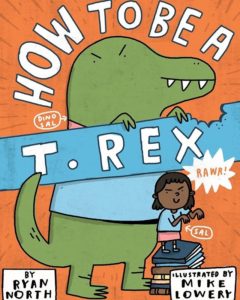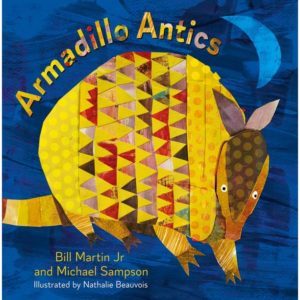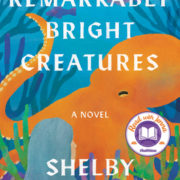How to Be A T. Rex by Ryan North and Armadillo Antics by Bill Martin, Jr., and Michael Sampson


How to Be A T. Rex by Ryan North, illustrated by Mike Lowery
Armadillo Antics by Bill Martin, Jr. and Michael Sampson, illustrated by Nathalie Beauvois
As grateful as I am for the magic of finding titles in the Library’s electronic catalog and as helpful as it can be when searching, I still think nothing beats leisurely browsing the shelves for something new (or new-to-me). There’s nothing like strolling through the stacks looking for a title that strikes my fancy. I found a pair of picture books hanging out together, just waiting for someone to pick them. They just so happen to be about animals (of one sort or another) and sources of eye-catching art. Both titles are fun, engaging, and great for reading aloud to little ones.
How to Be A T. Rex, written by Ryan North and illustrated by Mike Lowery, is a great place to start! Its bold art matches well with its brash main character. Sal is a little girl with a BIG agenda–she wants to be a Tyrannosaurus Rex when she grows up. (Or maybe even before then!) A dinosaur super fan, she loves that T. Rexes get to roar and stomp around and swat things (and people) with their tails. By sheer force of will and to spite her older brother, Sal turns herself into one and immediately initiates a mission of stomping, roaring intimidation. That is, until she’s sent to her room. There she learns the downside of living the dino life–she can’t wear her nifty shoes, her dog doesn’t like her as much, and it’s hard to be anything other than grumpy when all you can do is roar. Fortunately for Sal, she realizes the best of both worlds (human and dino) and invites her friends to be pretend dinosaurs with her.
Sal’s independent spirit comes through in Mike Lowery’s art. Vibrant orange and green and blue saturate the book cover to cover, emphasizing Sal’s energy and determination to live her best dinosaur life. Drawn in comic book style with bold black outlining and lettering (but minus the panel structure), most of the illustrations are full page with boisterous scenes and spirited, exclamatory text. Lowery’s technique is very effective at grabbing the reader’s attention, especially when it comes to showing all the amazing things a T. Rex can do. His illustrations also have a sense of humor and are great for exploring with a little one; Sal’s dinosaur-saturated bedroom is packed with details and worth a second or third look. Find a young person (or T. Rex) to delve into the book with or give it to a young reader to explore. How to Be A T. Rex is silly, rollicking good fun either way.
Despite its name, Armadillo Antics is less a madcap romp and more a relaxed opportunity to revel in rhyme and art. The book is an unhurried journey of the nocturnal mammal as it moves through its “day”. Each two-page spread features a rhyme and illustration depicting a different activity during the animal’s waking hours. For example, antics begin with “Armadillo, Armadillo, Armadillo, run. Romp and play till the night is done.” The rhyme is spread across two pages interspersed with frolicking cut-paper armadillos, cacti, and moon. “Armadillo” is a funny word to say no matter what, and this is no exception. The short rhymes and repetition of the text make this a great book for reading aloud to little ones. Reading aloud, observation, and language exploration are important components of early literacy and are put to good use here. Definitely share this one with toddlers, preschoolers, and early readers.
If Armadillo Antics seem vaguely familiar, it’s because the title is a collaboration of veteran picture book authors who have partnered with a contemporary illustrator who works in similar media as their earlier collaborators. Bill Martin, Jr. had a long career as a picture book author, including the well-known Brown Bear, Brown Bear, What Do You See? with legendary illustrator Eric Carle and Chicka Chicka Boom Boom with the equally legendary Lois Ehlert. All of the word repetition and rhyme and charming story of those classics are evident in Armadillo Antics. Although Martin died in 2004, he left an unpublished manuscript of this book, a collaboration with teacher and literacy advocate Micheal Sampson with whom he worked regularly.
Argentinian illustrator Nathalie Beauvois has a style that meshes well with that of Carle and Ehlert. Her collages of cut paper and paint create texture and motion on every page. The armadillo on the front cover wears armor in a tapestry of gold, rust, and brown triangles that are vibrant against the velvety blue background. Most of her palette is more subdued than those of Carle and Ehlert–less vibrant primary colors and more an exploration of natural, earthy tones–yet still full of nuance. This is a great title for practicing observation skills and starting conversations with pre- and early-readers. As a bonus, an armadillo fact sheet is included at the end of the book.
These two picture books proved delightful and fun to read. You can find them and a lot more stories about animals in the Children’s Department. I hope you enjoy them as much as I did. Happy reading!
Review written by: Beth Snow, Teen Services Librarian










